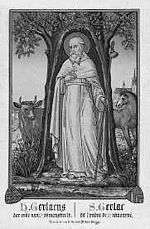Saint Gerlach
| Saint Gerlach | |
|---|---|
 | |
| Born |
c. 1100 Houthem, Netherlands |
| Died |
c. 1170 Houthem, Netherlands |
| Venerated in | Roman Catholic Church |
| Feast | January 5 |
| Attributes | portrayed in art as a hermit with an ass near him, or depicted in his hollow tree. He is also depicted with a thorn in his foot. |
| Patronage | domestic animals |
Saint Gerlach (Gerlache, Gerlac, Gerlachus van Houthem, Gerlac of Valkenberg) (d. c. 1170 AD) was a 12th-century Dutch hermit. His cult is centered at Houthem near Valkenburg in the south of the province of Limburg.
The Vita Beati Gerlaci Eremytae, written around 1227, describes his legend and life. Originally a licentious soldier and brigand, Gerlache became a pious Christian upon the death of his wife and went on pilgrimage to Rome and Jerusalem. At Rome, he nursed the sick for seven years. He also performed rites of penance for the sins of his youth.
Upon returning to the Netherlands, he gave up all of his possessions to the poor and took up residence in a hollow oak on his former estate near Houthem. He ate bread mixed with ash and traveled by foot each day on pilgrimage to Maastricht, to the Basilica of Saint Servatius. Despite his extreme austerity, he was engaged in a dispute with local monks, who wanted him to enter their monastery. The common people in the area considered him a saint, but these monks appealed to the local bishop. They accused Gerlach of actually being incredibly rich, his oak actually being the location of a cache of treasure. The bishop commanded that Gerlach's oak be cut down. Gerlach, however, had by this time made powerful friends, including Hildegard of Bingen, and received protection. Nevertheless, his oak was cut down, but the bishop found no treasure and wanted to make up his mistake to the saint by having the oak cut up in planks and having a small hut constructed with those.
Legend states that when Gerlach had done enough penance, water from the local well transformed itself into wine three times as a sign that his sins had been forgiven. He died shortly after, barely fifty and legend has it that the last rites were administered to him by the Saint Servatius himself.
The name
Gerlach is a male forename of Germanic origin, variations of which exist in many Germanic and Romance languages. Like many other early Germanic names, it is dithematic, consisting of two meaningful constituents put together. In this case, those constituents are ger (meaning 'spear') and /la:k / (meaning 'motion'). The meaning of the name is thus 'spear thrower'.
The church
The Sint-Gerlachus church in Houthem Sint-Gerlach is a well-known tourist site and the only religious building with frescos (paintings on marl) in the Netherlands.
 Church of Sint Gerlach, in Houthem
Church of Sint Gerlach, in Houthem- The reliquary of Saint Gerlach
Sources
- Saints of January 5: Gerlac
- Houthem-St. Gerlach (L): St. Gerlachus
- Bosworth-Toller Anglo-Saxon Dictionary: lác
External links
 Media related to Gerlachus van Houthem at Wikimedia Commons
Media related to Gerlachus van Houthem at Wikimedia Commons